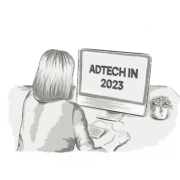The issue of transparency in digital advertising is a complicated topic. On one hand, various players along the supply chain each have a specific role to play and a business to run, therefore fees and charges need to be applied. On the other hand, brands and advertisers have a right to know how much of their ad spend is eaten up by various platforms and intermediaries, right?
Imagine this situation:
A man walks into a car dealership and inquires about purchasing a brand new car. The salesman tells him the car costs $25,000 in total. The man considers the price acceptable and agrees to purchase the car. Did the man ask the car salesman how much each individual part costs, or how much commission he was making on the sale? No. The man simply accepts that all these costs are part of the supply chain.
So should brands, advertisers, and publishers just accept the fact that fees and charges are simply part of the programmatic supply chain or should they demand transparency into the cost of media buys?
Regardless of which side of the argument you stand, one thing is for certain — transparency is a red-hot issue and relates to more than just fees (hidden or otherwise). It also covers other issues such as ad fraud, traffic, measurement, and viewability.
In order to help you understand the transparency issue in Ad Tech, we’ve covered it from three angles: the problems, the fallouts, and the solutions.
The Problems

The transparency issue in Ad Tech is not new.
If you follow the Ad Tech industry, or work in it, then you’ll know it’s been a problem for a number of years and is on the minds of everyone from brands to publishers.
A 2016 study by Strata found that the two main concerns US ad agencies had around programmatic were inventory quality and transparency into inventory sources.
For the most part, the lack-of-transparency issue can be broken up into two main parts:
- Fees, charges, and markups from vendors and intermediaries
- Ad fraud and ad viewability
Fees, Charges, and Markups From Vendors and Intermediaries
This area relates to the long programmatic supply chain that exists in today’s online advertising industry and relates to all fees, charges, and markups in display, native, video, and mobile, and covers costs associated with the purchase of media and data.

Each Ad Tech vendor and intermediary in the ecosystem is running a business, which means fees need to be charged and money needs to be made. While there is nothing wrong with that, this fragmented economy translates into brands and advertisers paying a much higher price for media than it’s actually worth.
But how much more?
According to a 2014 IAB report, about 55 percent of programmatic revenue was captured by Ad Tech services, while only 45 percent of the total programmatic revenue went to publishers. The real difference between how much an advertiser pays for media and how much the publisher actually receives varies greatly depending on how many vendors and intermediaries are at play.
Another joint study from the Association of National Advertisers (ANA), the Association of Canadian Advertisers (ACA), Ebiquity, and AD/FIN found that, on average, 42 percent of every dollar spent on programmatic went to either an Ad Tech company or agency, with 58 percent going to the publisher.
With figures like these, it’s no wonder a lack of transparency is a real concern for media buyers.
In order to add some clarity to transparency issues, the IAB has a Programmatic Fee Transparency Calculator that provides advertisers and marketers with an evaluation of programmatic technology, services, and inventory costs as a percentage of their effective cost-per mille (eCPM).

This side of the transparency issue relates to all cases where the Ad Tech vendor or intermediary isn’t transparent about the costs associated with media buying, whether that be about the markup they put on media or if the media is bought and sold via a first- or second-price auction.
Ad Fraud and Ad Viewability
Apart from a lack of transparency into the cost of media and data, there is also a lack of transparency into ad quality.
Ad fraud (which includes fake clicks and bot traffic) and ad viewability exacerbates the whole transparency problem, as advertisers are not only paying X percent more than the true cost of the media, but they are also buying fake impressions or ads that aren’t even seen by people.
It is often not known who the eventual beneficiary of the advertiser’s money is, which is what connects ad fraud with the transparency issue. When fraudulent media buys or activity are detected, they can be tracked and reported on, meaning advertisers are able to identify how much of their ad spend went to fraudsters and can even stop paying out money to the bad actors in the market, including both ad fraudsters and publishers who don’t implement proper ad-fraud controls or verification.
Ad fraud is a massive problem within online advertising, costing the industry (mainly advertisers) an estimated $6.5 billion a year.
While ad fraud is an issue that should be tackled by all parties in the ecosystem, the transparency around it should be provided by both the sell side (publishers and SSPs being transparent on whether they verify their traffic) and the buy side (vendors being transparent to media buyers as to whether they work with publishers and SSPs that verify their traffic).
In addition, more transparency needs to be delivered to media buyers as to whether their ads were actually seen by real users and not by bots, stuffed in a 1×1 pixel, or placed on an area of a page where the user doesn’t scroll to (but is still counted as an impression).
The Fallouts

It is beginning to seem that all players within the Ad Tech ecosystem are becoming frustrated with the issue of transparency and are finally taking action.
Recently, there have been two major stories that highlight this:
- The Guardian Suing Rubicon Project
- P&G Taking a Firm Stance Against Opaque Practices
The Guardian vs. Rubicon Project
The transparency ordeal came to a head in early 2017 when The Guardian sued Rubicon Project for “the recovery of non-disclosed buyer fees in relation of Guardian inventory”.
Rubicon Project states that the issues revolve around a contract dispute, which they will vigorously contest in court, and has sinced filed a counterclaim denying all liability.
The Guardian is claiming that Rubicon Project potentially withheld US$1.5 million (£1.2 million) over a six-year period, from 2010 to 2016.
There’s no doubt stories like this will appear over the coming years as brands and advertisers demand more transparency from Ad Tech vendors into fees, charges, and markups.
P&G Push for More Transparency
At the 2017 IAB Annual Leadership Meeting, Marc Pritchard, Chief Brand Officer of P&G, gave a game-changing speech (video below) that spoke directly to the transparency issue in digital advertising.
In short, P&G, the world’s largest advertiser, aims to clean up the online-advertising supply chain and improve transparency into all areas of its business by implementing a five-point action plan, which will roll out in 2017.
The plan includes the following action points:
1. Adopt one viewability standard (starts @ 7:46 in the video below)
The MRC standard requires at least 50 percent of pixels to be on screen for at least one second for display impressions, and at least 50 percent of the player to be on screen for at least two seconds for video.
2. Implement accredited third-party measurement verification (@11:36)
This action point involves adopting the MRC-accredited measurement verification standard and putting an end to the situation where the fox guards the hen house, which, for the most part, means ending the “wall garden” excuse and stopping companies and publishers from self-reporting.
3. Get transparent agency contracts (@14:51)
Pritchard revealed in his speech that P&G discovered one of their agencies made money on the float, essentially operating an arbitrage business whereby they would buy media from the brand at one price and sell it to the publishers at another, while making profit on the difference. P&G realized that this practice was included in the agency’s contract, meaning the agency was abiding by the contract 100 percent.
Pritchard then revealed that P&G would comb through agency contracts to see how the funds paid by the brand are used for advertising to get more transparency into how their media dollars are spent, and taking a closer look at matching fees for services to ensure joint value.
4. Prevent ad fraud (@17:37)
As Pritchard points out, tackling ad fraud is not a task that is able to be carried out by brands, advertisers, or even publishers; they simply lack the capabilities to combat sophisticated ad-fraud techniques. Ad fraud is a security issue, and as such, should be tackled by security-technology companies.
So in order to fight against fraud, P&G has teamed up with Trustworthy Accountability Group (TAG), a joint initiative with the Association of National Advertisers (ANA), the 4A’s and the IAB.
“This [TAG] is a powerful self-regulatory body aimed at eliminating fraudulent advertising and its partners in crime, such as sites that steal copyrighted content from our supply chain,” Pritchard explained during this talk.
5. Vote with our dollars (@19:46)
The final point is clear — P&G will only work with and buy media from entities that comply with their above action points.
Watch the video to see Marc Pritchard’s presentation in full:
Pritchard welcomes all businesses within the online advertising industry to use the same action points.
The (Potential) Solutions

So what’s the solution to the transparency issue in Ad Tech?
Is it the five-point action plan laid out by P&G’s Marc Pritchard, or does the solution lie in technology?
Let’s explore a couple of technological solutions that have emerged as a way to provide transparency in the online-advertising supply chain.
Blockchain Technology
Blockchain technology is the foundation of the cryptocurrency Bitcoin and is making waves in the financial and insurance industries as a way to securely move assets and asset ownership, among others, but more recently there’s been talk of blockchain technology being used in the online-advertising industry for securely and transparently transferring data between platforms and fighting ad fraud.
Although this sounds good in theory — use blockchain to conduct transactions that will allow everyone in the supply chain to see the exact price — in practice, it is much harder to implement.
For starters, the speed at which blockchain technology currently runs is way too slow to handle real-time transactions. Blockchain can take anywhere from 10 to 30 seconds to validate a transaction and add it to the public ledger; this amount of time is nowhere near the hundreds of milliseconds it currently takes most ad deals to finalize.
While the potential is there, it’s highly unlikely that blockchain technology will be used in online advertising in the near future.
Transparency-Oriented Platforms
In an attempt to tackle the transparency problem and differentiate themselves from the competition, a couple of transparency-oriented Ad Tech platforms have emerged — Havas being a prime example.
The idea is simple: provide something the industry and its competitors are lacking, which in this case is a flashlight inside the black boxes.
However, while companies in other industries have been able to capitalize on such opportunities, such as privacy and data ownership in web analytics, the transparency issue in digital advertising is a bit more complex.
For example, even though these transparency-focused platforms can show advertisers exactly how much they pay for media along the supply chain, it doesn’t mean hidden fees or duplicate bidding (when buyers bid on the same inventory through different platforms) will be picked up and reported.
While these two technological ideas might not be the final solution to an extremely complex problem, they certainly are a step in the right direction.
Final Thoughts
The transparency problem in Ad Tech presents more questions than it does final thoughts:
Will other companies in the online-advertising world adopt the five-point action plan presented by Marc Pritchard of P&G? If yes, how quickly?
Does the real solution to the lack of transparency lie in technology advancements, like the ones mentioned above?
What will a transparent supply chain do to the industry? For example, if all the costs, fees, and markups in the supply chain become known, what impact will this have on the cost of media?
Transparency seems to be the final frontier for Ad Tech; however, a number of things need to happen in order for any real change to occur.
For the most part, this includes consolidating platforms to reduce all the various fees charged by every single Ad Tech vendor and intermediary, and for companies to actually start being transparent and upfront about fees, traffic, quality, etc., but at the same time offering value that outweighs them.
Luckily, all of these things are already happening, although complete transparency is still a few (light) years away.







